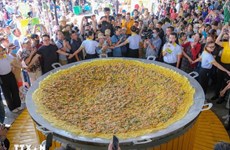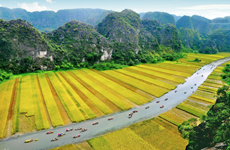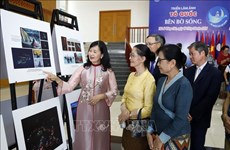Exploring record-making sites in scenic Da Lat
With cool weather year-round and idyllic misty valleys, lush pine
trees and colourful flowers, Da Lat city is making a name for itself
with domestic and international visitors. The “city of a thousand
flowers” is also home to numerous sites recognised by the Vietnam Record
Organisation.
With cool weather year-round and idyllic misty valleys, lush pine
trees and colourful flowers, Da Lat city is making a name for itself
with domestic and international visitors. The “city of a thousand
flowers” is also home to numerous sites recognised by the Vietnam Record
Organisation.
The Love Valley is one of the five largest valleys and top 20 favourite places in Vietnam, with its green pine forests and lakes where tourists can enjoy pedal-boating, horse riding, jeep safaris and canoeing.
To celebrate the traditional Lunar New Year (Tet), the valley’s flower gardens are being upgraded. A pair of dragon and peacock statues made by Thai craftsmen is on display for the first time at the tourist site as good luck wishes for visitors.
Another must-see item is the downtown “hell market”, now known as the Dat Lat night market. It is among the top five unique markets across the country and the top 5 most attractive night markets in Vietnam. The market offers a variety of cuisines, flowers, and locally-grown fruits and vegetables as well as handicrafts and silk embroidered items.
With only 39,000 VND (1.82 USD), visitors can partake in a buffet of jams and dried farm produce at a series of L’ang Farm stores along the two sides of Nguyen Thi Minh Khai street.
Outside the city, the Prenn waterfall is one of the top 5 most beautiful and magnificent falls in Vietnam. Visitors can ride elephants and see antique sets of musical instruments, jewellery, and labour tools dating back to the reign of the Hung Kings.
Spring is the best season in Da Lat. Tourists can take side trips to outlying areas to see traditional flower villages such as the Thai Phien and Ha Dong chrysanthemum village and the Van Thanh rose village, three of the top 10 flower villages in Vietnam.
Tuyen Lam Lake is one of the top five most charming and poetic natural lakes in Vietnam. The crystal-clear lake has a total area of 350 ha, surrounded by impressive mountains. Its deepest area is 23 metres.
On the top of the 2,000-meter Lang Biang Mountain, visitors get a picturesque overview of the city. It is named after two lovers – K’lang and the beautiful Ho Biang. He saved her life from a pack of wolves but tribal factions prevented them from marrying.
Two variations of the story are commonly told, with one account telling of their marriage and living together on the mountain until Biang was close to death with an illness. When K’lang returned to the tribe to ask for help, they shot him with a poisonous arrow. Biang, who had been following her husband, jumped in front of the arrow and died on the spot. K’lang could not suffer such a loss and his endless tears led to Dankia (the Golden Stream).
The second version is more Shakespearean, with the couple committing suicide together because they couldn’t marry.
In both versions, Biang’s father was so remorseful after his daughter’s death that he unified the tribes into one, called K’ho, and allowed the male and females of K’Ho to marry one another. The graves of the couple grew into two giant mountains, called Lang Biang in their honour.-VNA
The Love Valley is one of the five largest valleys and top 20 favourite places in Vietnam, with its green pine forests and lakes where tourists can enjoy pedal-boating, horse riding, jeep safaris and canoeing.
To celebrate the traditional Lunar New Year (Tet), the valley’s flower gardens are being upgraded. A pair of dragon and peacock statues made by Thai craftsmen is on display for the first time at the tourist site as good luck wishes for visitors.
Another must-see item is the downtown “hell market”, now known as the Dat Lat night market. It is among the top five unique markets across the country and the top 5 most attractive night markets in Vietnam. The market offers a variety of cuisines, flowers, and locally-grown fruits and vegetables as well as handicrafts and silk embroidered items.
With only 39,000 VND (1.82 USD), visitors can partake in a buffet of jams and dried farm produce at a series of L’ang Farm stores along the two sides of Nguyen Thi Minh Khai street.
Outside the city, the Prenn waterfall is one of the top 5 most beautiful and magnificent falls in Vietnam. Visitors can ride elephants and see antique sets of musical instruments, jewellery, and labour tools dating back to the reign of the Hung Kings.
Spring is the best season in Da Lat. Tourists can take side trips to outlying areas to see traditional flower villages such as the Thai Phien and Ha Dong chrysanthemum village and the Van Thanh rose village, three of the top 10 flower villages in Vietnam.
Tuyen Lam Lake is one of the top five most charming and poetic natural lakes in Vietnam. The crystal-clear lake has a total area of 350 ha, surrounded by impressive mountains. Its deepest area is 23 metres.
On the top of the 2,000-meter Lang Biang Mountain, visitors get a picturesque overview of the city. It is named after two lovers – K’lang and the beautiful Ho Biang. He saved her life from a pack of wolves but tribal factions prevented them from marrying.
Two variations of the story are commonly told, with one account telling of their marriage and living together on the mountain until Biang was close to death with an illness. When K’lang returned to the tribe to ask for help, they shot him with a poisonous arrow. Biang, who had been following her husband, jumped in front of the arrow and died on the spot. K’lang could not suffer such a loss and his endless tears led to Dankia (the Golden Stream).
The second version is more Shakespearean, with the couple committing suicide together because they couldn’t marry.
In both versions, Biang’s father was so remorseful after his daughter’s death that he unified the tribes into one, called K’ho, and allowed the male and females of K’Ho to marry one another. The graves of the couple grew into two giant mountains, called Lang Biang in their honour.-VNA













